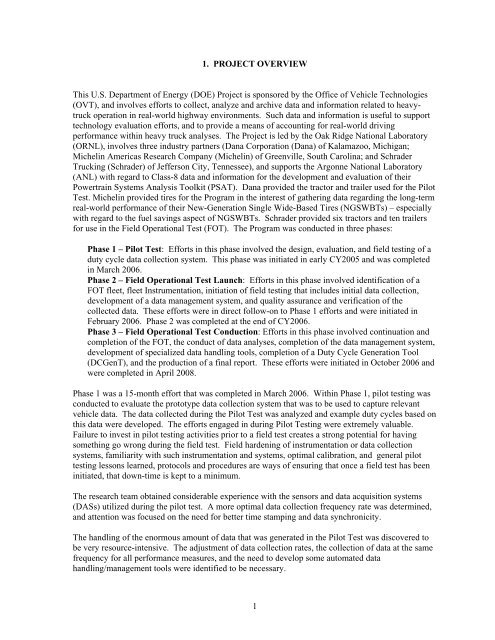Class-8 Heavy Truck Duty Cycle Project Final Report - Center for ...
Class-8 Heavy Truck Duty Cycle Project Final Report - Center for ...
Class-8 Heavy Truck Duty Cycle Project Final Report - Center for ...
You also want an ePaper? Increase the reach of your titles
YUMPU automatically turns print PDFs into web optimized ePapers that Google loves.
1. PROJECT OVERVIEW<br />
This U.S. Department of Energy (DOE) <strong>Project</strong> is sponsored by the Office of Vehicle Technologies<br />
(OVT), and involves ef<strong>for</strong>ts to collect, analyze and archive data and in<strong>for</strong>mation related to heavytruck<br />
operation in real-world highway environments. Such data and in<strong>for</strong>mation is useful to support<br />
technology evaluation ef<strong>for</strong>ts, and to provide a means of accounting <strong>for</strong> real-world driving<br />
per<strong>for</strong>mance within heavy truck analyses. The <strong>Project</strong> is led by the Oak Ridge National Laboratory<br />
(ORNL), involves three industry partners (Dana Corporation (Dana) of Kalamazoo, Michigan;<br />
Michelin Americas Research Company (Michelin) of Greenville, South Carolina; and Schrader<br />
<strong>Truck</strong>ing (Schrader) of Jefferson City, Tennessee), and supports the Argonne National Laboratory<br />
(ANL) with regard to <strong>Class</strong>-8 data and in<strong>for</strong>mation <strong>for</strong> the development and evaluation of their<br />
Powertrain Systems Analysis Toolkit (PSAT). Dana provided the tractor and trailer used <strong>for</strong> the Pilot<br />
Test. Michelin provided tires <strong>for</strong> the Program in the interest of gathering data regarding the long-term<br />
real-world per<strong>for</strong>mance of their New-Generation Single Wide-Based Tires (NGSWBTs) – especially<br />
with regard to the fuel savings aspect of NGSWBTs. Schrader provided six tractors and ten trailers<br />
<strong>for</strong> use in the Field Operational Test (FOT). The Program was conducted in three phases:<br />
Phase 1 – Pilot Test: Ef<strong>for</strong>ts in this phase involved the design, evaluation, and field testing of a<br />
duty cycle data collection system. This phase was initiated in early CY2005 and was completed<br />
in March 2006.<br />
Phase 2 – Field Operational Test Launch: Ef<strong>for</strong>ts in this phase involved identification of a<br />
FOT fleet, fleet Instrumentation, initiation of field testing that includes initial data collection,<br />
development of a data management system, and quality assurance and verification of the<br />
collected data. These ef<strong>for</strong>ts were in direct follow-on to Phase 1 ef<strong>for</strong>ts and were initiated in<br />
February 2006. Phase 2 was completed at the end of CY2006.<br />
Phase 3 – Field Operational Test Conduction: Ef<strong>for</strong>ts in this phase involved continuation and<br />
completion of the FOT, the conduct of data analyses, completion of the data management system,<br />
development of specialized data handling tools, completion of a <strong>Duty</strong> <strong>Cycle</strong> Generation Tool<br />
(DCGenT), and the production of a final report. These ef<strong>for</strong>ts were initiated in October 2006 and<br />
were completed in April 2008.<br />
Phase 1 was a 15-month ef<strong>for</strong>t that was completed in March 2006. Within Phase 1, pilot testing was<br />
conducted to evaluate the prototype data collection system that was to be used to capture relevant<br />
vehicle data. The data collected during the Pilot Test was analyzed and example duty cycles based on<br />
this data were developed. The ef<strong>for</strong>ts engaged in during Pilot Testing were extremely valuable.<br />
Failure to invest in pilot testing activities prior to a field test creates a strong potential <strong>for</strong> having<br />
something go wrong during the field test. Field hardening of instrumentation or data collection<br />
systems, familiarity with such instrumentation and systems, optimal calibration, and general pilot<br />
testing lessons learned, protocols and procedures are ways of ensuring that once a field test has been<br />
initiated, that down-time is kept to a minimum.<br />
The research team obtained considerable experience with the sensors and data acquisition systems<br />
(DASs) utilized during the pilot test. A more optimal data collection frequency rate was determined,<br />
and attention was focused on the need <strong>for</strong> better time stamping and data synchronicity.<br />
The handling of the enormous amount of data that was generated in the Pilot Test was discovered to<br />
be very resource-intensive. The adjustment of data collection rates, the collection of data at the same<br />
frequency <strong>for</strong> all per<strong>for</strong>mance measures, and the need to develop some automated data<br />
handling/management tools were identified to be necessary.<br />
1
















